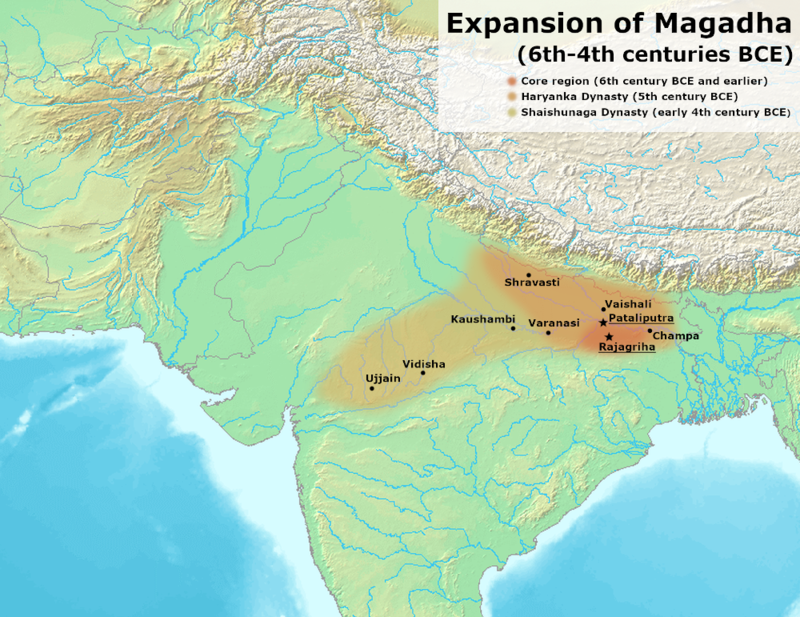Magadha came into prominence under the leadership of Bimbisara of the Haryanka dynasty and a contemporary of the Buddha.
He began the policy of conquest and aggression which ended with the Kalinga war of Ashoka.
Bimbisara acquired Anga and placed it under the viceroyalty of his son Ajatashatru at Champa. He also strengthened his position by marriage alliances.

Image Source: upload.wikimedia.org/wikipedia/commons/thumb/3/31/Magadha_Expansion_%286th-4th_centuries_BCE%29.png/800px-Magadha_Expansion_%286th-4th_centuries_BCE%29.png
ADVERTISEMENTS:
He had three wives. Bimbisara’s first wife was the daughter of the king of Koshala and the sister of Prasenajit, the son and successor of the Koshalan king. The Koshalan bride brought Bimbisara as dowry a Kashi village yielding a revenue of 100,000 which suggests that revenues were collected in terms of coins.
The marriage bought off the hostility of Koshala and gave Bimbisara a free hand in dealing with the other states. His second wife, Chellana, was a Lichchhavi princess from Vaishali who gave birth to Ajatashatru, and his third wife was the daughter of the chief of the Madra clan of Punjab. Marriage relations with the different princely families lent enormous diplomatic prestige and paved the way for the expansion of Magadha westward and northward.
Magadha’s most serious rival was Avanti with its capital at Ujjain. Its king, Chanda Pradyota Mahasena, fought Bimbisara, but eventually the two thought it wise to make up. Later, when Pradyota was afflicted by jaundice, at the Avanti king’s request, Bimbisara sent the royal physician Jivaka to Ujjain. Bimbisara is also said to have received an embassy and a letter from the ruler of Gandhara with which Pradyota had fought unsuccessfully. Therefore, through his conquests and diplomacy, Bimbisara made Magadha the dominant state in the sixth century BC. His kingdom is said to have consisted of 80,000 villages, a number which sounds conventional.
The earliest capital of Magadha was at Rajgir, which was called Girivraja at that time. It was surrounded by five hills, the openings in which were closed by stone walls on all sides, which made it impregnable. According to the Buddhist chronicles, Bimbisara ruled for fifty-two years, roughly from 544 to 492 BC. He was succeeded by his son Ajatashatru (492—60 BC). Ajatashatru killed his father and seized the throne for himself. His reign saw the high watermark of the Bimbisara dynasty. He fought two wars and made preparations for the third. Throughout his reign he pursued an aggressive policy of expansion.
ADVERTISEMENTS:
This provoked a combination of Kashi and Koshala against him. There began a prolonged conflict between Magadha and Koshala. Eventually Ajatashatru got the best of the war, and the Koshalan king was compelled to purchase peace by giving his daughter in marriage to Ajatashatru and leaving him in sole possession of Kashi. Ajatashatru was no respecter of relations. Although his mother was a Lichchhavi princess, this did not prevent him from making war against Vaishali. The excuse was that the Lichchhavis were the allies of Koshala. He sowed dissension within the ranks of the Lichchhavis and eventually ended their independence by invading their territory and by defeating them in battle.
This took him full sixteen years. He was eventually successful in doing so because of a war engine like a catapult which was used to hurl stones. He also possessed a chariot to which a mace was attached, and this facilitated mass killings. The Magadhan empire was thus enlarged with the addition of Kashi and Vaishali. Ajatashatru faced a stronger rival in the ruler of Avanti. Avanti had defeated the Vatsas of Kaushambi and now threatened an invasion of Magadha. To meet this threat Ajatashatru began the fortification of Rajgir, the remains of the walls of which can still be seen. However, the invasion did not materialize during his lifetime.
Ajatashatru was succeeded by Udayin (460-44 BC). His reign is important because he is said to have built a fort at the confluence of the Ganges and Son at Patna. This was done because Patna lay at the centre of the Magadhan kingdom, which now extended from the Himalayas in the north to the hills of Chhotanagpur in the south. Patna’s position, as will be seen later, was crucially strategic.
Udayin was succeeded by the dynasty of Shishunagas, who temporarily moved the capital to Vaishali. Their greatest achievement was the destruction of the power of Avanti with its capital at Ujjain. This brought to an end the 100-year old rivalry between Magadha and Avanti. From now onwards Avanti became a part of the Magadhan empire and continued to be so till the end of Maurya rule.
ADVERTISEMENTS:
The Shishunagas were succeeded by the Nandas, who proved to be the most powerful rulers of Magadha. So great was their power that Alexander, who invaded Punjab at that time, dared not move towards the east. The Nandas extended the Magadhan power by conquering Kalinga from where they brought an image of jina as a victory trophy. All this took place during the reign of Mahapadma Nanda. This ruler claimed to be ekarat, the sole sovereign who had destroyed all the other ruling princes. It seems that he captured not only Kalinga but also Koshala which had probably rebelled against him.
The Nandas were fabulously rich and enormously powerful. It is said that they maintained 200,000 infantry, 60,000 cavalry, and 3000 to 6000 war elephants. Such a huge army could be maintained only through an effective taxation system. Obviously these considerations prevented Alexander from advancing against the Nandas. The later Nandas proved to be weak and unpopular. Their rule in Magadha was supplanted by that of the Maurya dynasty under which the Magadhan empire reached the apex of glory.